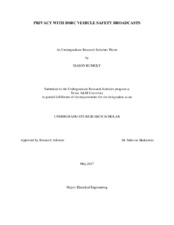Privacy with DSRC Vehicle Safety Broadcasts
Abstract
Dedicated Short Range Communications (DSRC) is an emerging technology application allowing vehicles to communicate with each other for safety improvements. The current protocol calls for open broadcast of Basic Safety Message (BSM) reports every 100ms; these contain the time, location, speed, acceleration in three dimensions, and other attributes of the car at that point in time along with a broadcast identification (ID) randomized at random intervals. This protocol introduces privacy vulnerabilities, as anyone with a compatible device can track a vehicle’s movement. The primary aim of this research is to expose the privacy shortfalls and ultimately determine how much information to omit in order to preserve users’ privacy. In order to do this, I analyzed a data set of BSM messages generated from a two month deployment of the technology in an Ann Arbor, Michigan study by the US Department of Transportation (DOT). While my colleagues focused on connecting individual points, I focused on the specific question of reconnecting vehicle path segments across significant broadcast gaps and IDs changes using driver behavior. I simulated the problem by choosing an intersection in Ann Arbor, taking multiple paths through it, splitting the paths across it, and omitting any time data as well as any BSMs within 50m of the intersection. I wrote a preliminary algorithm to create statistical profiles of the paths, from which it then attempted to match the ‘before’ and ‘after’ paths. This basic algorithm is able to match the paths with better accuracy than random guessing, but becomes less potent the more paths are introduced. As this crude method is able to stitch paths together on a harder problem than is likely in practical situations, it is likely more sophisticated methods would achieve even higher accuracy, implying that privacy is not protected sufficiently by changing ID or neglecting to broadcast during periods, as future work shall seek to determine.
Citation
Rumuly, Mason Christopher (2017). Privacy with DSRC Vehicle Safety Broadcasts. Undergraduate Research Scholars Program. Available electronically from https : / /hdl .handle .net /1969 .1 /164550.


